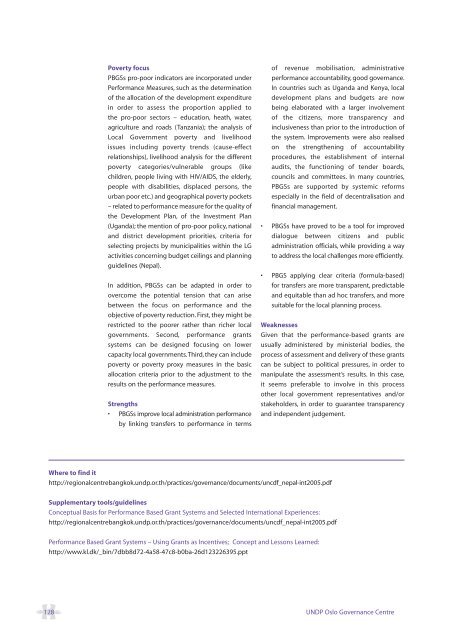A Users' Guide to Measuring Local Governance
A Users' Guide to Measuring Local Governance
A Users' Guide to Measuring Local Governance
You also want an ePaper? Increase the reach of your titles
YUMPU automatically turns print PDFs into web optimized ePapers that Google loves.
Poverty focus<br />
PBGSs pro-poor indica<strong>to</strong>rs are incorporated under<br />
Performance Measures, such as the determination<br />
of the allocation of the development expenditure<br />
in order <strong>to</strong> assess the proportion applied <strong>to</strong><br />
the pro-poor sec<strong>to</strong>rs – education, heath, water,<br />
agriculture and roads (Tanzania); the analysis of<br />
<strong>Local</strong> Government poverty and livelihood<br />
issues including poverty trends (cause-effect<br />
relationships), livelihood analysis for the different<br />
poverty categories/vulnerable groups (like<br />
children, people living with HIV/AIDS, the elderly,<br />
people with disabilities, displaced persons, the<br />
urban poor etc.) and geographical poverty pockets<br />
– related <strong>to</strong> performance measure for the quality of<br />
the Development Plan, of the Investment Plan<br />
(Uganda); the mention of pro-poor policy, national<br />
and district development priorities, criteria for<br />
selecting projects by municipalities within the LG<br />
activities concerning budget ceilings and planning<br />
guidelines (Nepal).<br />
In addition, PBGSs can be adapted in order <strong>to</strong><br />
overcome the potential tension that can arise<br />
between the focus on performance and the<br />
objective of poverty reduction. First, they might be<br />
restricted <strong>to</strong> the poorer rather than richer local<br />
governments. Second, performance grants<br />
systems can be designed focusing on lower<br />
capacity local governments.Third, they can include<br />
poverty or poverty proxy measures in the basic<br />
allocation criteria prior <strong>to</strong> the adjustment <strong>to</strong> the<br />
results on the performance measures.<br />
Strengths<br />
• PBGSs improve local administration performance<br />
by linking transfers <strong>to</strong> performance in terms<br />
of revenue mobilisation, administrative<br />
performance accountability, good governance.<br />
In countries such as Uganda and Kenya, local<br />
development plans and budgets are now<br />
being elaborated with a larger involvement<br />
of the citizens, more transparency and<br />
inclusiveness than prior <strong>to</strong> the introduction of<br />
the system. Improvements were also realised<br />
on the strengthening of accountability<br />
procedures, the establishment of internal<br />
audits, the functioning of tender boards,<br />
councils and committees. In many countries,<br />
PBGSs are supported by systemic reforms<br />
especially in the field of decentralisation and<br />
financial management.<br />
• PBGSs have proved <strong>to</strong> be a <strong>to</strong>ol for improved<br />
dialogue between citizens and public<br />
administration officials, while providing a way<br />
<strong>to</strong> address the local challenges more efficiently.<br />
• PBGS applying clear criteria (formula-based)<br />
for transfers are more transparent, predictable<br />
and equitable than ad hoc transfers, and more<br />
suitable for the local planning process.<br />
Weaknesses<br />
Given that the performance-based grants are<br />
usually administered by ministerial bodies, the<br />
process of assessment and delivery of these grants<br />
can be subject <strong>to</strong> political pressures, in order <strong>to</strong><br />
manipulate the assessment’s results. In this case,<br />
it seems preferable <strong>to</strong> involve in this process<br />
other local government representatives and/or<br />
stakeholders, in order <strong>to</strong> guarantee transparency<br />
and independent judgement.<br />
Where <strong>to</strong> find it<br />
http://regionalcentrebangkok.undp.or.th/practices/governance/documents/uncdf_nepal-int2005.pdf<br />
Supplementary <strong>to</strong>ols/guidelines<br />
Conceptual Basis for Performance Based Grant Systems and Selected International Experiences:<br />
http://regionalcentrebangkok.undp.or.th/practices/governance/documents/uncdf_nepal-int2005.pdf<br />
Performance Based Grant Systems – Using Grants as Incentives; Concept and Lessons Learned:<br />
http://www.kl.dk/_bin/7dbb8d72-4a58-47c8-b0ba-26d123226395.ppt<br />
128 UNDP Oslo <strong>Governance</strong> Centre








![GuÃa del Usuario ] - Governance Assessment Portal](https://img.yumpu.com/44740603/1/190x253/gua-a-del-usuario-governance-assessment-portal.jpg?quality=85)







